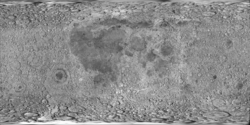Römer (cráter)
| Römer Cráter lunar | ||
|---|---|---|
 Imagen de la misión Lunar Orbiter 4 | ||
| Coordenadas | 25°26′N 36°25′E / 25.43, 36.41 | |
| Diámetro | 40 km | |
| Profundidad | 3.3 km | |
| Colongitud | 324° al amanecer | |
| Epónimo | Ole Rømer | |
|
Localización sobre el mapa lunar | ||



Römer es un cráter de impacto que se encuentra al norte del Sinus Amoris en la sección noreste de la Luna, en la parte suroeste de la región montañosa llamada Montes Taurus. Al oeste-noroeste se halla el cráter-bahía Le Monnier, en el borde este del Mare Serenitatis.
 |
El borde de Römer tiene paredes relativamente altas, con una superficie interior aterrazada. Presenta un pequeño cratercillo en la parte norte del suelo del cráter, y un gran pico central en su punto medio. Römer posee un sistema de marcas radiales, y debido a estos rayos, se clasifica como parte del Período Copernicano.[1]
Al noroeste del cráter aparece un sistema prominente de grietas denominado Rimae Römer, que sigue un curso al norte del borde occidental del cráter, y tiene una longitud combinada de cerca de 110 kilómetros.
Cráteres satélite
[editar]Por convención estos elementos son identificados en los mapas lunares poniendo la letra en el lado del punto medio del cráter que está más cercano a Römer.
 |
|
Los siguientes cráteres han sido renombrados por la UAI:
- Römer K - Véase Franck (cráter).
- Römer L - Véase Brewster (cráter).
Véase también
[editar]Referencias
[editar]- (WGPSN), IAU Working Group for Planetary System Nomenclature (13 de febrero de 2013). «Gazetteer of Planetary Nomenclature. 1:1 Million-Scale Maps of the Moon» (en inglés). UAI / USGS. Consultado el 6 de abril de 2016.
- Andersson, L. E.; Whitaker, E. A., (1982). NASA Catalogue of Lunar Nomenclature (en inglés). NASA RP-1097.
- Blue, Jennifer (25 de julio de 2007). «Gazetteer of Planetary Nomenclature» (en inglés). USGS. Consultado el 2 de enero de 2012.
- Bussey, B.; Spudis, P. (2004). The Clementine Atlas of the Moon (en inglés). Nueva York: Cambridge University Press. ISBN 0-521-81528-2.
- Cocks, Elijah E.; Cocks, Josiah C. (1995). Who's Who on the Moon: A Biographical Dictionary of Lunar Nomenclature (en inglés). Tudor Publishers. ISBN 0-936389-27-3.
- McDowell, Jonathan (15 de julio de 2007). «Lunar Nomenclature» (en inglés). Jonathan's Space Report. Consultado el 2 de enero de 2012.
- Menzel, D. H.; Minnaert, M.; Levin, B.; Dollfus, A.; Bell, B. (1971). «Report on Lunar Nomenclature by The Working Group of Commission 17 of the IAU». Space Science Reviews (en inglés) 12: 136.
- Moore, Patrick (2001). On the Moon (en inglés). Sterling Publishing Co. ISBN 0-304-35469-4.
- Price, Fred W. (1988). The Moon Observer's Handbook (en inglés). Cambridge University Press. ISBN 0521335000.
- Rükl, Antonín (1990). Atlas of the Moon (en inglés). Kalmbach Books. ISBN 0-913135-17-8.
- Webb, Rev. T. W. (1962). Celestial Objects for Common Telescopes, 6ª edición revisada (en inglés). Dover. ISBN 0-486-20917-2.
- Whitaker, Ewen A. (2003). Mapping and Naming the Moon (en inglés). Cambridge University Press. 978-0-521-54414-6.
- Wlasuk, Peter T. (2000). Observing the Moon (en inglés). Springer. ISBN 1-85233-193-3.
- «Lunar Impact Crater Database» (en inglés). Lunar and Planetary Institute (USRA). Consultado el 12 de septiembre de 2017.
Enlaces externos
[editar]- Referencia UAI del CRÁTER
- LPI Digital Lunar Orbiter Photographic Atlas of the Moon
- Mapa LROC
- The-moon.wikispaces.com: Römer Archivado el 1 de marzo de 2020 en Wayback Machine.
 Wikimedia Commons alberga una categoría multimedia sobre Römer.
Wikimedia Commons alberga una categoría multimedia sobre Römer.
Text is available under the CC BY-SA 4.0 license; additional terms may apply.
Images, videos and audio are available under their respective licenses.

